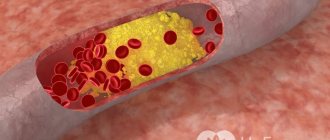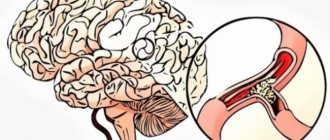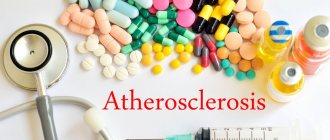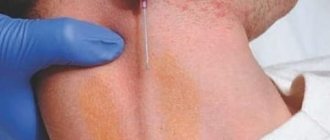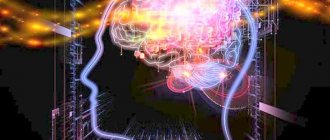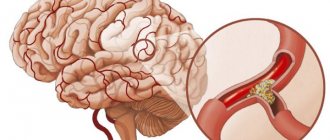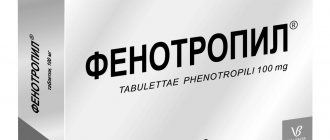What is a disease?
This disease is caused by a violation of the tone of the arteries in the head. This pathology does not allow the vessels to adapt normally to any changes - both external and internal. The result of cerebral angiodystonia is inadequate functioning of the veins, their function is disrupted, which disrupts regional blood flow, which affects the activity of all body systems. Today, both adults and children are susceptible to a similar illness, although previously the disease was usually diagnosed in older people.
The cause of this disorder is damage to the vascular walls, which occurs under the influence of another disease. This disease is considered very serious by doctors and requires immediate treatment. As soon as characteristic signs appear, you should immediately consult a doctor, since the development of pathology can lead to disability and even death. According to the classification of the disease ICD-10 revision, it is assigned a code - G45, but this is the most suitable option for the disorder, which is usually used for ischemic diseases. Specifically, angiocerebral dystonia does not have a separate code in the international classification of diseases.
To understand this complex name, you need to define the term itself. Angiodystonia is a mixture of two words from Latin and Russian. Angio means “vascular,” and “dystonia” means vascular disease. The pathological process extends not only to arteries of all types, but also to the resistive region, which includes capillaries, arterioles and other types of blood vessels. The venous system of the brain is also subject to destructive effects - this means both their spasm and expansion.
Background pathologies
Almost always, angiodystonia develops against the background of other cerebral pathologies. Sometimes it occurs due to infectious or endocrine diseases. Background processes include:
- Atherosclerosis of the arteries. With this pathology, endothelial damage occurs and fatty plaques form. Due to the thickening of the walls of blood vessels, the elasticity of the arteries decreases, which can result in a decrease in muscle tone.
- Hormonal disorders. Most often, angioedema is combined with diseases of the pituitary gland and thyroid gland. Decompensated diabetes mellitus also leads to vascular damage.
- Chronic infectious diseases that affect not only the brain, but also other organs.
- Traumatic brain injury.
- Psycho-emotional disorders, stress.
- Systemic vascular diseases – vasculitis. Such pathologies can be either infectious or autoimmune in nature.
- Allergic reactions.
If the cause of this syndrome cannot be determined, this does not mean that it does not exist. In most cases, the development of dystonia is preceded by any disorders of the endocrine system or head trauma. In cases of damage during childbirth, the syndrome may develop much later (at school age).
Classification and symptoms
Signs of cerebral angiodystonia directly depend on the form of the disease. The treatment process is also associated with the type of disease, so it is important to diagnose exactly what causes discomfort in a person.
Types of angiocerebral dystonia:
- Hypertensive, it is also considered spastic, since during the manifestation of this class of disease, vascular spasm occurs, causing severe pain in the head, which occurs suddenly. Due to this influence, venous blood flow is disrupted, which causes discomfort. Symptoms: pulsating sensations in the temporal zone, pain in the heart area. The history of such patients usually indicates that he suffers from arrhythmia and arterial hypertension. The hyperconstrictive type of pathology belongs to the same variety.
- Hypotonic. This type of disease occurs against the background of a pronounced expansion of the lumen of blood vessels, which provokes the appearance of certain symptoms. Signs: migraine-like pain in the head, the patient may even lose consciousness. In addition, severe weakness occurs and the patient’s performance is impaired. The person is unable to bear either physical or emotional stress. Sometimes short-term memory loss is recorded. Often such people are diagnosed with hypotension. Angiopathy of this class is quite common.
- Mixed angiodystonic type. The disease can occur in any form, with vasodilation or narrowing. Among the manifestations, disorders of hearing and visual function may predominate; in addition, a violation of the sense of smell often occurs. Another severe symptom is the inability to perceive information, especially complex information. Pain in the back and joints of all extremities, an increase or decrease in arterial levels are also recorded in such patients.
The main symptom of this disease is headache, which can occur at any time of the day or night. These sensations are not affected by overwork, stress, emotional or physical. Cephalgia, characterized by the amount of similar discomfort covering the entire area of the skull from the back of the head to the eyebrows, can bring a person to a state of shock or fainting. Therefore, people who have experienced angiodystonia know first-hand what it is.
The nature of the pain can be aching, sharp or throbbing, which often leads to depression and breathing problems. Symptoms of this disease can occur in different ways. There are indirect signs by which the doctor begins to suspect angiodystonic syndrome and a disorder of vascular function, their vagotonic or vasomotor processes.
Main manifestations:
- noise in the ears and head;
- blood pressure surges;
- impaired attention and memory;
- dizziness;
- sleep disorder;
- heaviness in the head area;
- increased heart rate or decreased relative to normal;
- numbness of hands and feet;
- manifestations of dyspeptic form.
When diagnosing, doctors detect changes in the vessels characteristic of angiodystonia, the combination of which indicates precisely this diagnosis.
Deviations:
- narrowing of the lumen of the arteries;
- displacement of blood vessels and veins;
- cerebral blood flow becomes weaker.
Varieties of this pathology also include a neurogenic or primary type of dystonic disease, and there is also a systemic or limited form of the disease, which is classified depending on the location of the focus. You can accurately identify the nature and localization of the problem using a rheoencephalogram, which will show the level of vasoconstriction, stage of the disease, hypertonicity or strong relaxation of blood vessels and many other characteristics.
An angiodystonic crisis can seriously worsen the patient’s well-being and lead to serious consequences. Therefore, treatment of the disease must begin at an early stage, before dangerous complications arise.
Cerebral angiodystonia with cephalgic syndrome
Cerebral angiodystonia is a serious disease that is associated with the fact that the walls of blood vessels in the brain begin to change dramatically. Because of this, the ability of the vessels to adapt to various changes gradually weakens.
Because of this, blood circulation in this area deteriorates.
Reasons for the development of pathology
The reasons that lead to such a serious illness are different. Considering the nature of the disease and the disorders that gradually appear, doctors distinguish symptomatic and primary forms of angiodystonia. In most cases, negative changes in blood vessels that affect the tone of veins and arteries are secondary and symptomatic.
Basically, this pathology is provoked by another serious disease. By the way, in this case, treatment should be aimed primarily at the primary ailment, and then treat cerebral dystonia. Vascular pathologies can develop against the background of diseases of the endocrine and autonomic systems.
Most often this is a consequence of atherosclerotic processes in the brain.
Many of our readers actively use a well-known method based on natural ingredients, discovered by Elena Malysheva, to treat HEART DISEASES. We recommend that you check it out.
Doctors identify a number of factors that can provoke a disease such as cerebral angiodystonia of cerebral vessels. Firstly, this may be due to hormonal imbalances, which are caused by problems in the functioning of the endocrine system.
Secondly, problems with blood vessels are in some cases associated with disorders of the autonomic nervous system. Thirdly, amyloidosis can also cause similar pathologies. In some cases, the problem is pancreatitis, when inflammatory processes develop in the pancreas. This can also cause cerebrovascular disease.
In some cases, the problem is related to other organs of the gastrointestinal tract.
If there are infectious foci in the body, then they must be treated so that they do not develop into chronic forms. Some diseases of the central nervous system also cause secondary pathologies with arteries and veins. This pathological phenomenon is strongly associated with blood vessels.
Sometimes brain injuries (for example, concussions) also cause angiodystonia as a complication. By the way, most often the pathology is of the hypertensive type.
If a person leads a sedentary, inactive lifestyle, then angiodystonia can gradually develop, so you definitely need to play sports or at least take a walk every day.
Very often, varicose veins can cause such an unpleasant complication in the brain. The same goes for Addison's disease. If increased intracranial pressure is observed frequently, then angiodystonia may be of the hypertensive type. With extensive smoking experience, such side effects are also possible.
Spondylosis is also dangerous. Also, angiodystonia may appear due to menopause or certain characteristics of the body. For example, this concerns constant anxiety, irritability, and suspiciousness. By the way, external factors can also adversely affect the body and cause such a complication.
For example, this applies to poor nutrition.
Symptoms of cerebral angiodystonia
Sometimes there is a feeling of heaviness in the neck and head. The syndrome is characterized by noise and ringing in the ears. Sometimes dark spots appear before the eyes. By the way, this depends on what type of disease it is (hypotonic or hypertensive).
Sometimes other symptoms appear. For example, a patient complains of deteriorating hearing and vision, poor attention, and memory.
Symptoms such as pain in the back, limbs and neck are also typical. Clinical studies indicate changes in the condition of blood vessels in the brain.
They can become very narrow. Sometimes veins or arteries become dislodged. Blood flow weakens.
Treatment of cerebral angiodystonia
Cerebral angiodystonia is a serious disease, so the symptoms of this disease cannot be ignored. If the syndrome is secondary, then you must first treat the primary disease that caused problems with the blood vessels of the brain.
The doctor selects treatment individually for each person. Therapy for blood vessels must be comprehensive. You definitely need to do therapeutic exercises and set aside at least half an hour for this every day. This will help quickly restore the tone of blood vessels. In addition, warm baths have a beneficial effect on the body.
They need to be taken every other day. In some cases, the doctor recommends a contrast shower. A patient with VSD must take a walk in the fresh air every day. You definitely need to get your daily routine back to normal. Every day a person needs at least 6-8 hours to sleep.
Physical activity and rest should be alternated in a timely manner, and rest should be complete. It is recommended to reduce psycho-emotional stress. You need to surround yourself with a good atmosphere and have positive emotions. This is very useful for cerebral type VSD.
Many of our readers actively use a well-known method based on natural ingredients, discovered by Elena Malysheva, to treat VSD. We recommend that you check it out.
As for traditional medicine, you can use various medicinal plants. For example, a decoction and tincture of valerian and motherwort are suitable.
These remedies have a general strengthening and calming effect, so they are perfect for patients with a hypertensive type of disease, especially if they have a tendency to spastic reactions. Patient supervision by a doctor is required.
Before using medications and traditional medicine, you should consult a doctor so as not to worsen your health condition.
If a person has cerebral dystonia, it is recommended to adhere to dietary rules. Without proper nutrition it is impossible to get rid of this pathology. It is imperative to give up junk food that contains large amounts of refractory animal fat. Fast carbohydrates are also harmful to the patient's health.
In addition, it is better not to drink carbonated and alcoholic drinks. If you have a vascular problem, it is not recommended to indulge in spices, spicy, fried, fatty foods, marinades, sauces, smoked meats, etc. By the way, you also need to give up bad habits, like smoking. This will help prevent the further development of a disease such as cerebral dystonia.
In addition, its manifestation will be much easier for a person.
You need to eat in small portions, but often.
Such fractional meals are very useful. It is imperative to include fresh fruits, berries, vegetables and herbs in your diet for VSD. Foods rich in vitamin C are especially beneficial for blood vessels.
It not only thins the blood and strengthens the immune system, but also makes the walls of blood vessels more flexible, stronger and more elastic. With VSD, this is beneficial for the whole body.
It is allowed to steam, oven or boil.
Having carefully studied Elena Malysheva’s methods in the treatment of VSD and overall health of the body, we decided to offer it to your attention.
Summarizing
Cerebral angiodystonia is a severe pathological process that is associated with impaired tone of blood vessels in the brain. Because of this, blood circulation in the brain deteriorates, which leads to other serious complications. When the first symptoms appear, it is imperative to begin treatment for VSD, but it is best not to delay it, but to engage in prevention.
- Do you often experience discomfort in the head area (squeezing, pressing or throbbing pain)?
- You are haunted by a feeling of fatigue, depression, apathy, and loss of strength.
- Pain in joints and muscles, spasms in internal organs.
- There is nothing to say about shortness of breath after the slightest physical exertion...
- And you have been taking a bunch of medications for a long time.
Source: https://atmrm.ru/cerebralnaja-angiodistonija-s-cefalgicheskim/
Causes
Angiodystonia of cerebral vessels is a pathology of a secondary form, so the underlying disease must be treated first. The factor leading to arterial dysfunction is considered to be a violation of their tone. Damage to vascular tissue can spread to both their upper and lower layers, which determines the nature of the course of the disease.
Risk factors and underlying diseases that provoke cerebral angiodystonia:
- somatic diseases;
- pathologies of infectious or viral nature;
- neurocircular dystonia;
- traumatic brain injuries;
- disorders in the endocrine system;
- VSD (vegetative-vascular dystonia);
- excess body weight;
- lack of physical activity;
- intoxication;
- constant stress;
- bad habits, drug addiction;
- herpetic lesions;
- syphilis, as well as tuberculosis;
- phlebeurysm;
- atherosclerotic manifestations;
- menopause period;
- spondylosis or osteochondrosis;
- transitional age.
If cerebral angiodystonia is detected in a child, then usually the cause of this disease is birth trauma, severe toxicosis during pregnancy in the expectant mother, some pathologies of the woman, as well as a protracted labor process. Cephalgic syndrome can appear in babies, which causes significant discomfort for children and forces parents to urgently consult a doctor. Even when there is one sign of this disease in a child, it is necessary to begin therapy, since such diseases respond well to treatment in young patients.
Neurohumoral regulation controls the narrowing or expansion of arteries, under the influence of one or another process occurring in the body. Vasodilation begins after increased stress on the brain, muscle tissue, and internal organs. Under the influence of such reactions, blood flow and oxygen delivery to all systems increases.
The task of the venous department is to exert the proper influence on such a process. The flow of waste blood rushes to the lung area, where it is enriched with oxygen. The correct activity of the parasympathetic and sympathetic departments ensures the normal response of the arteries to all stimuli, both internal and external. If a disorder of all these processes is recorded, the vessels are spasmed, their tone is increased, then the blood supply to the whole body is disrupted, oxygen deficiency appears, and VBB (vertebrobasilar) insufficiency may develop, which is a reversible pathology of the brain.
Among other things, there is angiodystonia of the retina, which is detected by ophthalmologists when checked by ophthalmoscopy. The complication is often complete loss of vision. This disease, in combination with such brain damage, is dangerous; it can lead to discircular ecephalopathy, in which the activity of this brain organ is disrupted. Subcompensation is due to the lack of adequate treatment and the causes of the disease.
Manifestations
At the initial stage, it is very difficult to detect the presence of angiodystonia of retinal vessels. The disease does not bother you and does not even manifest itself in any way. Only after some time the following symptoms begin to appear:
- decreased visual acuity;
- pulsation inside the eye;
- blurred vision, flashes, clouding;
- reduction of the boundaries of the visible field;
- yellow spots and broken vessels that become visible on the conjunctiva of the eye;
- impairment in the form of farsightedness.
Both eyes or only one may be affected. If the disease develops into a severe form, then even loss of vision is possible.
Diagnostics
The examination of the patient begins with a survey; the doctor needs to clarify all the person’s complaints. After this, the doctor prescribes diagnostic measures to identify the clinical picture of the disease. Today there are techniques that can study the condition of blood vessels and their response to stimuli.
Examination methods:
- UZGD;
- rheoencephalography (REG);
- echographic research method;
- ECG;
- electroencephalography;
- consultation with some specialists, neurologist, psychiatrist;
- ophthalmoscopy.
Separately, it is worth highlighting rheoencephalography. With the help of such diagnostics, you can find out what condition the vessels are in and how they react to filling with blood. There are varieties of the disease that indicate the cause of the pathology, for example, normotonic, spondylogenic and other types of illness.
To exclude organic diseases, doctors examine the patient’s blood and urine, and also perform an ultrasound of the abdominal cavity.
Treatment
Therapy for cerebral angiodystonia is always complex; it is aimed at eliminating the underlying disease and normalizing arterial tone. The medication method involves taking certain medications. Each drug is prescribed by a doctor; you cannot independently adjust the drugs prescribed by the doctor (name, dose, active substance).
Pills:
- Vasoactive agent - "Methyldopa", "Clonidine" and others.
- Antihypertensive drugs - “Bisoprolol”, “Captopril”, “Tenoric”.
- Painkillers - “Ketonal”, “Pentalgin”.
- Antiri, "Verapamil".
- Sedative - “Persen”, “Seduxen”, “Corvalol”.
- Drugs to increase blood circulation in the brain - Pentoxifylline, Vinpocetine, Piracetam.
- Antioxidants and vitamins.
- Eye drops - “Emoxipin”, “Taufon”.
In addition to drug treatment, you can improve and speed up the healing process with the help of alternative medicine. There is a vibration method of therapy, it is not yet popular, but is already considered very effective. Some people prefer to choose a safe folk remedy; its properties can increase the speed of blood flow and have many other beneficial effects. Any treatment method must be agreed with a doctor, as it may have contraindications.
There are many complications from cerebral angiodystonia, it all depends on the extent of the pathological process and the type of disease. Encephalopathy is one of the most common consequences of this disease.
Folk remedies
When using folk remedies, it is important to choose herbal decoctions that correspond to the type of dystonia. So, for low blood pressure, tonic herbs are used, and for high blood pressure, soothing herbs are used. Herbal therapy is effective at the initial stage of the disease, with long-term treatment. The following decoctions and infusions are easy to prepare at home:
- a mixture of hawthorn, St. John's wort and valerian;
- a mixture of hawthorn, rose hips, motherwort;
- a mixture of St. John's wort, mint, lemon balm.
Valerian has the most powerful calming effect. For low blood pressure and bradycardia, ginseng, eleutherococcus, dandelion, and alfalfa effectively tone the body. To improve the condition of blood vessels, it is useful to drink freshly squeezed juices from carrots, beets, and pumpkins. To quickly relieve headaches due to cerebral dystonia, experts advise washing your face with cold water or soaking your feet in cold water for several minutes. You can perform a light massage of the temporal area.
Prevention
In order to reduce the risk of pathology, you need to follow some prevention methods. In addition, if angiodystonia has already developed in a person, these actions will help avoid further progression of the disease.
Recommendations:
- physical activity;
- adequate rest and sleep time;
- regular walks in the fresh air;
- proper diet;
- normalization of body weight;
- rejection of bad habits;
- regularly conducting prescribed tests and taking medications.
Many, not knowing what cerebral angiodystonia is, attribute ailments and pain to fatigue. More often, the pathology proceeds calmly, without complications or consequences, but the quality of life of people is significantly reduced. Therefore, you should consult a doctor immediately as soon as you experience headaches that occur regularly.
Diseases affecting the brain seriously impair the well-being of patients and therefore require immediate treatment. If therapy is not applied in a timely manner, then illnesses can greatly disrupt the processes in this organ, which will negatively affect all body systems. Vascular pathologies disrupt the blood supply to the head and other parts, due to this the person suffers from intense pain, as well as other unpleasant symptoms.
How to get rid of cerebral angiodystonia
Cerebral angiodystonia is a functional pathology characterized by disruption of arterial and venous tone of cerebral vessels and a decrease in their adaptive capabilities. The pathology is based on a violation of the nervous regulation of blood vessels, due to which:
- The brain is not supplied with the required amount of blood.
- Venous blood stagnates in the brain.
Angiodystonia of cerebral vessels is a functional disorder in which the morphological substrate of arteries and veins remains intact: they do not have atherosclerosis or blood clots.
The pathology affects 1.7% of the population. Among all functional disorders of the cardiovascular system, cerebral dystonia occurs in 20% of cases. 30-35% of patients are young people of working age.
The danger of the disease is that it can imitate other pathologies of the central nervous and cardiovascular systems. Because of this, diagnosing the root cause is difficult and incorrect treatment is prescribed. The prescribed therapy in this case turns out to be harmful to the patient and reduces his quality of life.
After a medical commission, the patient is assigned fitness category “B”. This means that he is not taken into the army for service in peacetime, but can be drafted into wartime.
Causes
Cerebral angiodystonia of cerebral vessels has the following causes:
- Diseases of the endocrine organs: pheochromocytoma, hyperthyroidism, hypothyroidism, diabetes mellitus.
- Dysregulation of the autonomic nervous system.
- Neuroinfections: meningitis, encephalitis, meningoencephalitis.
- Consequences of traumatic brain injury.
- Acute or chronic intoxication with alcohol, nicotine, drugs, fumes, food poisoning, hangover.
- Occupational diseases: vibration disease, exposure to loud noise.
- Psycho-emotional disorders due to prolonged stress, lack of sleep, neuropsychic stress.
- Diseases of internal organs.
- Arterial hypertension, hypertension.
- Severe cerebral angiodystonia in children occurs due to congenital pathologies of the central nervous system, for example, against the background of problematic pregnancy
Violation of vascular tone is often considered a psychosomatic pathology. An unconstructive approach (alcoholism, addictive behavior) or a person’s lack of skills to eliminate mental stress leads to chronic stress, psycho-emotional tension and disruption of the autonomic nervous system.
Classification
Cerebral angiodystonia syndrome is classified in several ways:
By origin:
- Primary. Primary angiodystonia of a cerebral nature is an independent disease. It is also called neurogenic.
- Symptomatic. Violation of vascular tone acts as a symptom or complication of the underlying disease, for example, hypertension.
By localization:
- Local. Local disturbance of vascular tone is observed in one organ, as in cerebral angiodystonia.
- Systemic or diffuse cerebral angiodystonia. Violation of vascular tone is observed throughout the body.
With the flow:
- Constant angiodystonia. Manifests itself as persistent cerebral circulatory disorders.
- Crisis. It manifests itself as periodic sharp deterioration in well-being - this is cerebral angiodystonia with paroxysms.
By type of dystonia:
- Hypertensive type. It is observed with high blood pressure, when the blood vessels of the brain are in a state of spasm, the lumen of the vessel is reduced due to contraction of the muscular wall of the artery.
- Mixed type. It is characterized by fluctuations in the state of the walls of blood vessels, during which they can contract or relax. Depends on the current psychophysiological state.
- Hypotonic type. Occurs in people prone to low blood pressure. The walls of the vessels are relaxed and their lumen is increased.
By severity:
- Mild dystonia.
- Moderately severe cerebral angiodystonia.
- Severe cerebral angiodystonia.
The degree determines the severity of the clinical picture of vascular pathology of the brain.
Symptoms
The clinical picture of cerebral angiodystonia is nonspecific. General signs of cerebral angiodystonia:
- Emotional and mental disorders: frequent mood swings, irritability and fatigue, absent-mindedness, memory loss, rapid fatigue from simple work, shallow sleep, increased time to fall asleep, apathy, decreased interest in surrounding events and hobbies.
- Autonomic disorders: shortness of breath and irregular breathing rhythm, palpitations, fluctuations in blood pressure, increased heart rate.
The clinical picture consists of syndromes. The dominance of a particular syndrome depends on the congenital or acquired weakness of an organ or system. So, if the patient has a congenital heart defect, the dominant syndrome will be cardiac neurosis. List of syndromes combined with angiodystonia of cerebral vessels:
- Cardialgic. The patient complains of pain in the heart. Painful sensations are bursting, burning or aching in nature. Most often localized at the apex of the heart. The pain lasts from a few minutes to 1-2 hours. The pain goes away if the patient is distracted by something emotionally significant and interesting. Severe pain is usually accompanied by fear, anxiety, agitation and shortness of breath.
- Breathing disorder syndrome. It is observed in more than 85% of patients with angiodystonia. Typical symptoms: a feeling of lack of air, shortness of breath and suffocation, discomfort in the lungs and upper respiratory tract.
Crisis, or paroxysmal angiodystonia can be accompanied by crises of three types:
- Sympathoadrenal crisis. It is characterized by the following symptoms:
- sudden onset of anxiety and fear;
- aching headache that occurs suddenly; the patient complains of a feeling of pulsation in the head;
- high blood pressure;
- feeling of strong heartbeat;
- pale and dry skin;
- trembling of limbs;
- increase in body temperature.
At the end of the first type of crisis, excessive urination and general weakness are observed.
- Parasympathetic crisis:
- bursting headache;
- nausea, vomiting;
- decreased blood pressure;
- decreased heart rate per minute, shortness of breath;
- dizziness;
- hyperhidrosis, moist and warm skin.
- A mixed crisis combines symptoms of a crisis of the first and second types.
There are three degrees of severity of paroxysmal crises with angiodystonia:
- Easy. Manifests itself as a separate syndrome. The attack lasts no more than 20 minutes.
- Average. Symptoms include two syndromes simultaneously. The attack lasts from 20 minutes to 1 hour. After the crisis, exhaustion is observed, which lasts 1-2 days.
- Heavy. Manifested by 2 or more syndromes, severe autonomic dysfunction with cerebral angiodystonia and convulsive seizures. The attack lasts more than 1 hour. Exhaustion after an attack lasts 2-3 days. In adults, working capacity is reduced at this time.
Clinical picture of individual forms:
- Cerebral angiodystonia with venous dysfunction. It is based on a violation of the tone of the venous vessels of the brain. Because of this, venous outflow in the brain is disrupted and blood is retained. Symptoms similar to hypertensive-hydrocephalic syndrome occur: nausea, vomiting, aching headache, apathy, irritability, sensitivity to bright light and loud sounds.
- Signs of angiodystonia of cerebral vessels of the hypotensive type. Occurs if systolic blood pressure falls below 100 mmHg. Emotional and mental disorders are the same as with standard angiodystonia. Autonomic disorders are manifested by chilliness of the extremities and a tendency to faint due to insufficient blood supply to the brain. The skin is pale in appearance and cold and damp to the touch. During work, blood pressure is normal, but at rest it decreases. The tone of peripheral vessels decreases.
- Hypertensive type. The pathology occurs as a discirculatory encephalopathy. It is characterized by a decrease in psychophysiological indicators: memory, attention, pace of thinking, speed of reactions. Autonomic disorders come to the fore: an increase in heart rate per minute from 80 to 130, an increase in heart rate with excitement, extrasystole, visible pulsation of the vessels of the neck and head.
Cerebral angiodystonia in a teenager is caused by endocrinological changes in the body, which causes spontaneous outbursts of aggression, excessive sensitivity, and negativism. A transient mental state can provoke the psychosomatics of angiodystonia. Cerebral angiodystonia at 16 years of age in school-age children is the peak incidence.
Cerebral angiodystonia during pregnancy has a similar reason - wasting resources on adapting to a new lifestyle leads to psycho-emotional stress and psychosomatic disorders.
Concomitant diseases
Violation of vascular tone is accompanied by many diseases:
- Encephalopathy. This disease occurs due to a chronic cerebral circulation disorder, resulting in the death of brain cells. Accompanied by intellectual, vegetative and emotional disorders. At first, the disease is functional and reversible, but if atherosclerosis joins angiodystonia over time, the defect becomes irreversible.
- Hypertonic disease. The pathology is based on a sustained increase in systolic blood pressure above 140 mm Hg. Due to the increased tone of the vascular walls, the minute-by-minute volume of blood circulation in the large and small vessels of the brain decreases, which is why it suffers from ischemia and hypoxia.
- Cardiopsychoneurosis. It is characterized by pain in the heart, rhythm disturbances and fluctuations in blood pressure. Usually has a mixed type.
Diagnostics
Angiodystonia is a diagnosis of exclusion. It is set if no other organic and functional pathologies of the cerebral vessels are identified. Diagnostic searches can last for months, since the clinical picture is varied and nonspecific.
Diagnosis is carried out by a neurologist, endocrinologist, psychiatrist and cardiologist. Initially, a family history of autonomic dysfunction is established: whether immediate relatives had a disorder of vascular regulation of the brain.
The presence of concomitant diseases is established.
Typically, patients with dysregulation of vascular tone experience gastric and duodenal ulcers, bronchial asthma, skin diseases, allergies, hypertension, arrhythmias and endocrine diseases.
Instrumental diagnostic methods include electrocardiography, electroencephalography, computed tomography and functional tests using provoking drugs.
Treatment
The basis of treatment is lifestyle correction. Patients need to learn to regulate their work and rest schedule, sleep the proper number of hours, and limit smoking and alcohol.
Treatment of angiodystonia is complex. It includes:
- Drug therapy. Prescription of medications depends on symptoms. If the patient complains of agitation, anxiety, sleep disturbance, sedatives, anxiolytics or hypnotics are used. For apathy and inaction, on the contrary, drugs with a stimulating effect.
- Psychotherapy. Methods of rational psychotherapy and autogenic training with elements of relaxation are used.
- Therapeutic exercise. Exercise therapy is designed for general strengthening of the body.
- The diet for cerebral angiodystonia is a balanced diet with a predominance of B vitamins.
The original article is posted here: https://sortmozg.com/zabolevaniya/tserebralnaya-angiodistoniya
Source: https://zen.yandex.ru/media/id/5b55bb6e9d6d6f00aa31e8ef/5dcfe835af919452a14aecf9


